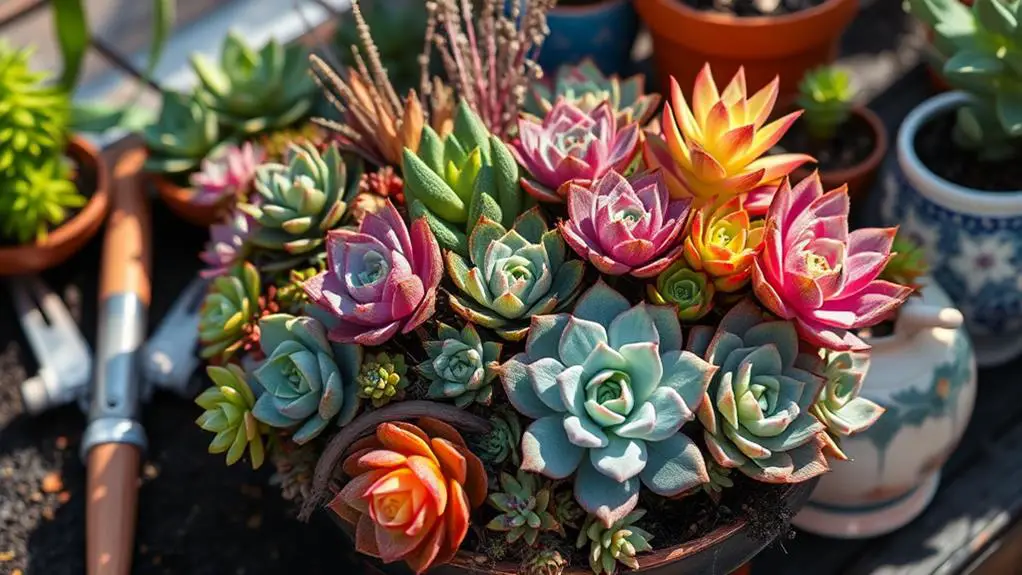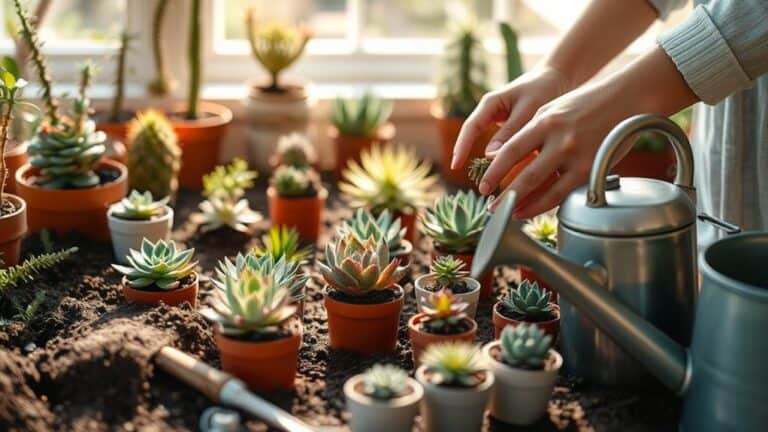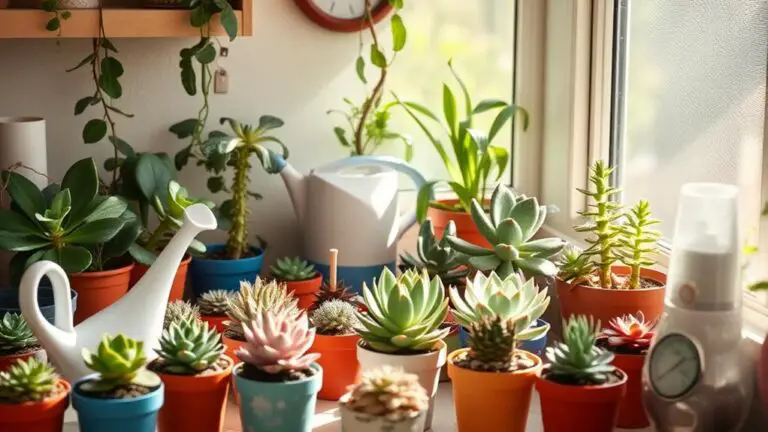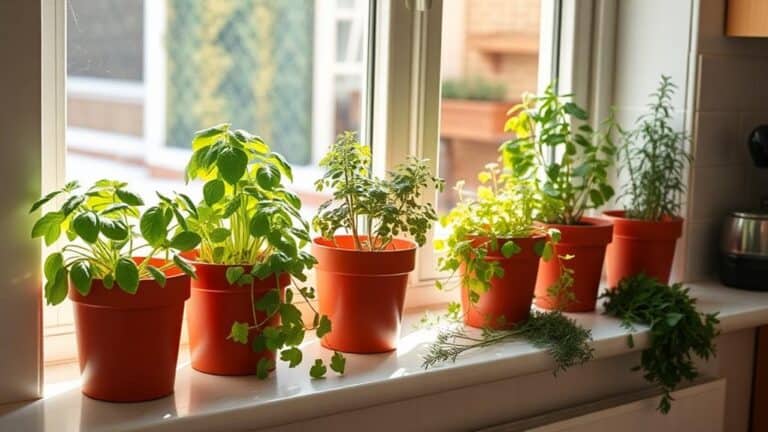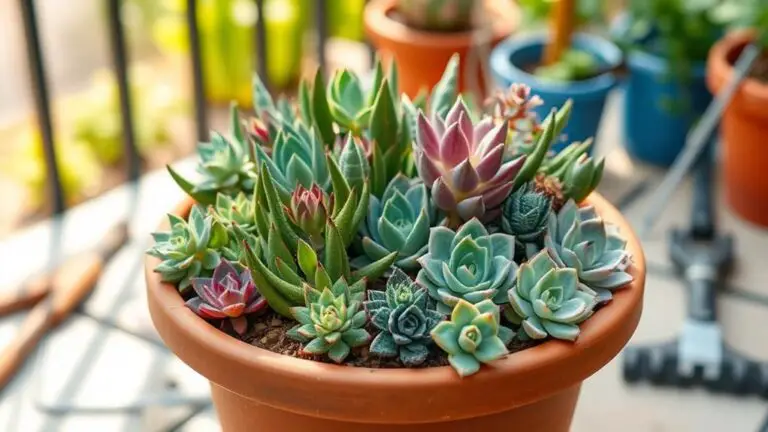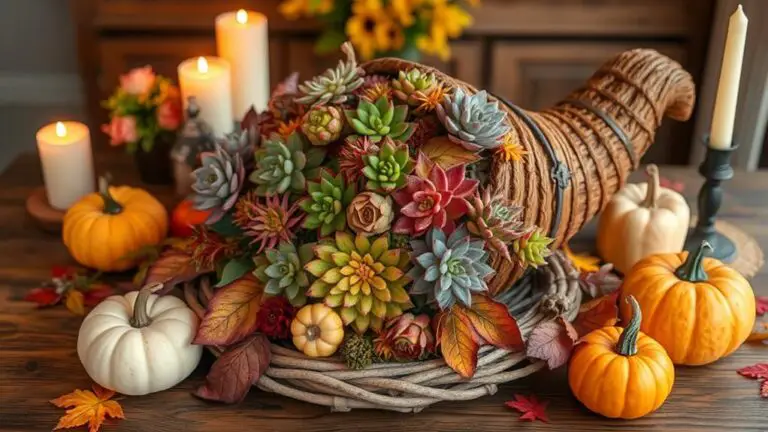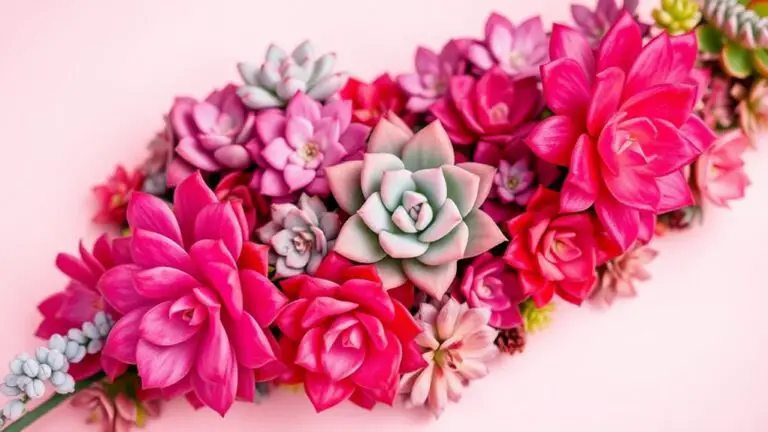Creating a Stunning Succulent Bouquet Garden – A Step-by-Step Guide
Imagine transforming a simple container into a vibrant succulent bouquet garden that's both stunning and low-maintenance. You'll need to gather a few essential materials and tools, but don't worry, it's straightforward. Start by preparing a decorative container with proper drainage to support your plants' health. Next, think about the types of succulents you'll choose—variety in color, shape, and size will make your arrangement pop. Arranging them thoughtfully is key, but what should go where? And how do you guarantee they thrive? Let's explore each step to create a living masterpiece.
Materials and Tools Needed
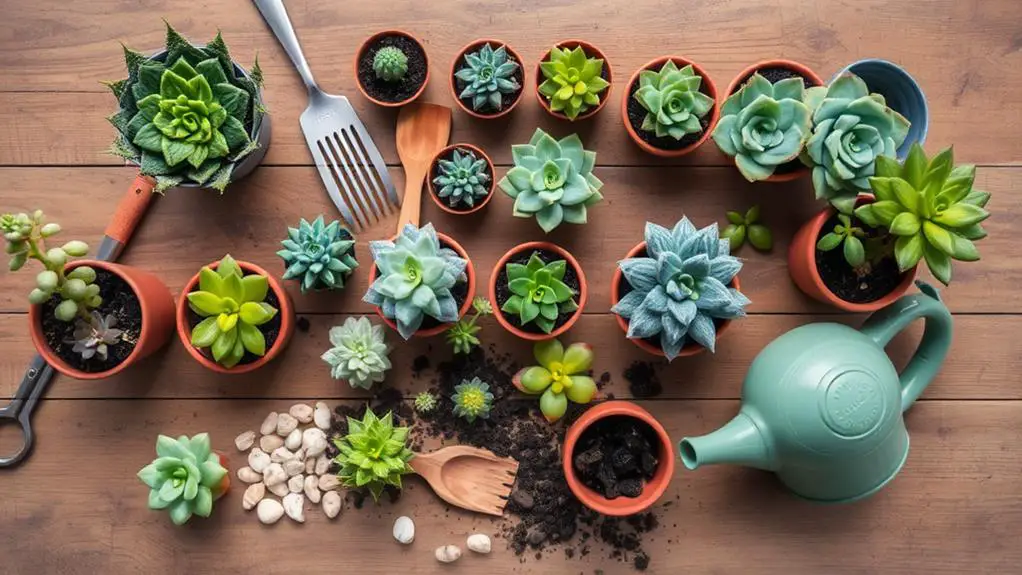
To create a stunning succulent bouquet garden, you'll need to gather a variety of vibrant succulents like Echeveria, Sedum, and Aeonium.
Start by selecting healthy plants, as their color and condition will greatly impact your garden's visual appeal.
Next, choose a decorative container that suits your style. A pedestal pot or an urn works wonderfully, but make certain it has a drainage hole. This is essential for water management, preventing root rot. Aim for a container about 12 inches in diameter and 8 inches tall.
You'll also need a well-draining potting mix, ideally a cactus mix. This type of soil helps with aeration and keeps your succulents' roots healthy.
Equip yourself with essential tools: scissors for trimming, a trowel for planting, and gloves for protection. These will make the planting process smoother.
To enhance the aesthetics, consider adding decorative elements like stones or moss. They can create a beautiful finish and support your garden's structure.
For larger arrangements, materials like landscape fabric and chicken wire will help stabilize the stems and keep everything in place.
Following these guidelines will guarantee you're well-prepared to create a beautiful and thriving succulent bouquet garden.
Preparing Your Container
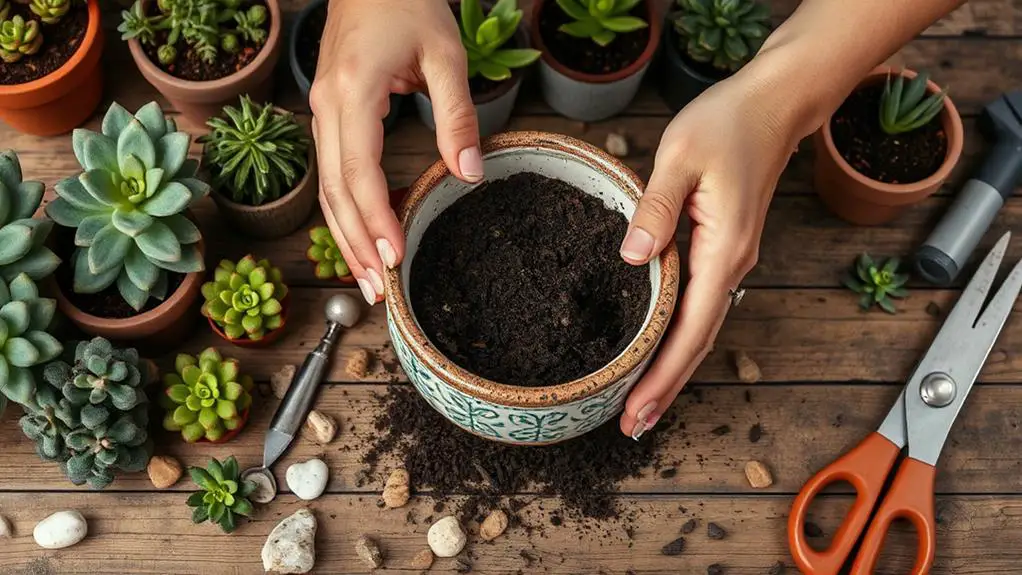
A well-prepared container is the foundation of your succulent bouquet garden's success. First, you need to choose a decorative container that suits your design. Make certain it has the right dimensions, like a 12-inch diameter urn with an 8-inch height, and a drainage hole or insert for water management. This helps prevent water from pooling and causing root rot.
Before you start, clean the container thoroughly. Remove any dust or debris to provide a fresh start for your succulent arrangement. Once your container is sparkling clean, you're ready for the next steps.
To guarantee proper drainage, place rocks or gravel at the bottom of the container. This layer helps to keep water from sitting in the soil, which can damage your succulents.
Next, fill the container with well-draining potting mix. Leave enough space at the top for arranging your succulents and make sure the soil is leveled for stability.
Consider lining the container with landscape fabric to retain soil while still allowing for drainage. This can promote better moisture control within your arrangement.
- Choose a decorative container with a drainage hole
- Clean it thoroughly before use
- Add rocks or gravel for proper drainage
Choosing the Right Succulents
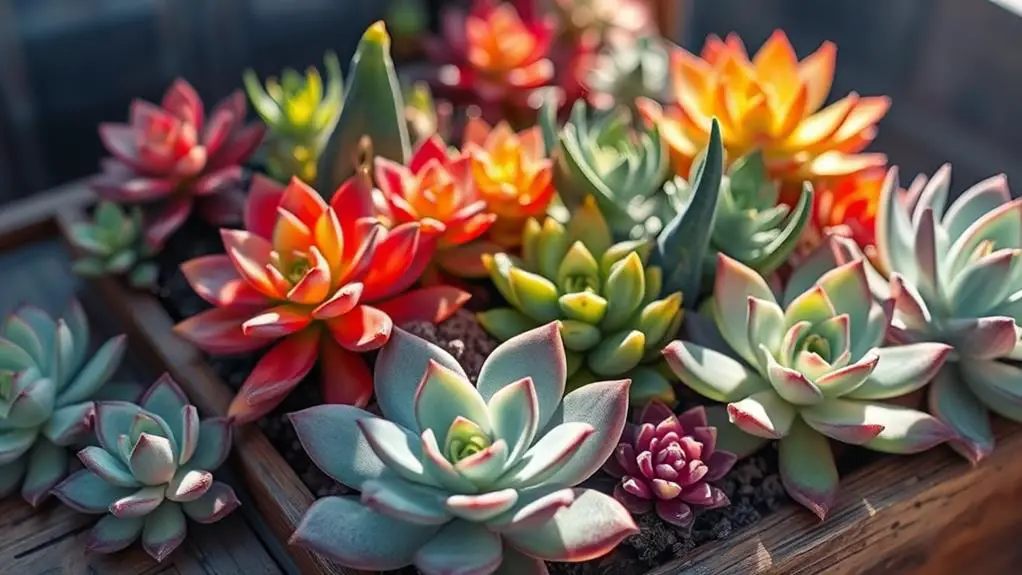
Selecting the perfect succulents for your bouquet garden involves combining a variety of shapes, sizes, and colors to create visual interest.
You'll want to mix trailing, upright, and rosette forms to achieve a really dynamic arrangement. Start by choosing healthy, vibrant plants with firm leaves. Make sure they're suited to your local climate and the current season for ideal growth and longevity.
Opt for seasonal varieties like Sunburst aeonium and Echeveria Perle von Nurnberg, which thrive in different conditions and enhance your bouquet's appeal.
Consider each succulent's growth habits. Position larger plants toward the back or center, and use medium and smaller plants to fill in around them. This creates balance and depth in your garden.
When selecting colors, think about coordinating hues to create a cohesive look. You might really love the look of contrasting colors like purple balloon flowers paired with ghost echeveria.
Arranging the Plants
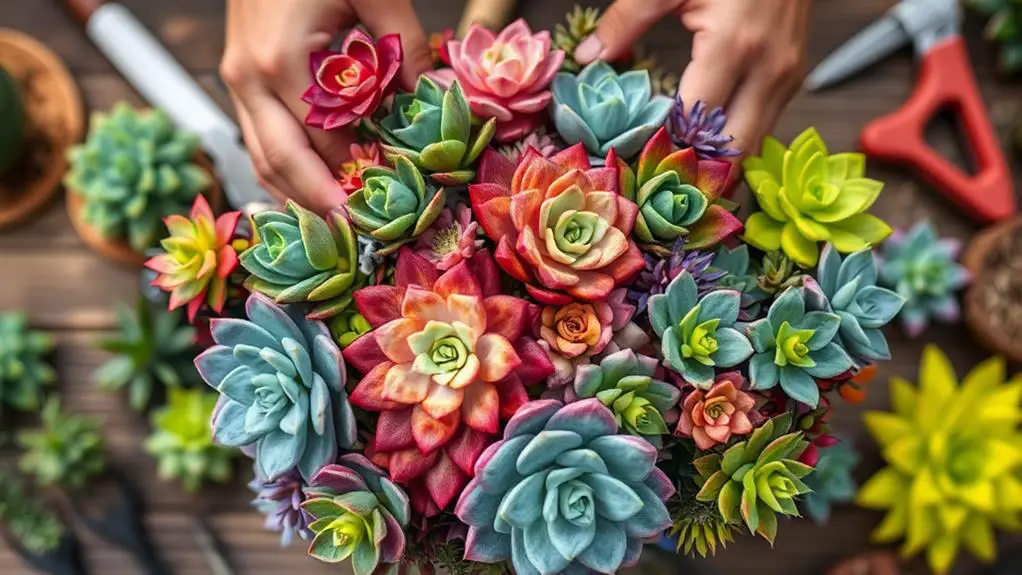
Kicking off your succulent bouquet garden, start by positioning the larger succulents at the back or center of your container. This creates a solid foundation and gives your arrangement visual depth.
Once you've got your big plants in place, add medium-sized succulents around them. This fills in gaps and keeps the design balanced.
Next, introduce smaller succulents at the front or edges. These little guys enhance visual interest and help create a layered effect that you'll really love the look of.
Make certain to vary the heights and textures of your plants. This variation guarantees your arrangement is dynamic and eye-catching.
Remember to:
- Cover all roots well with soil.
- Pack the potting mix around the plants for stability.
- Adjust plants as needed for balance.
As you arrange, take your time to step back and view your work from different angles. This helps you see if any areas need tweaking.
You'll find that a bit of patience and careful placement pays off, making your succulent bouquet garden truly stunning.
Don't rush; enjoy the process and watch as your beautiful creation takes shape.
Adding Decorative Elements
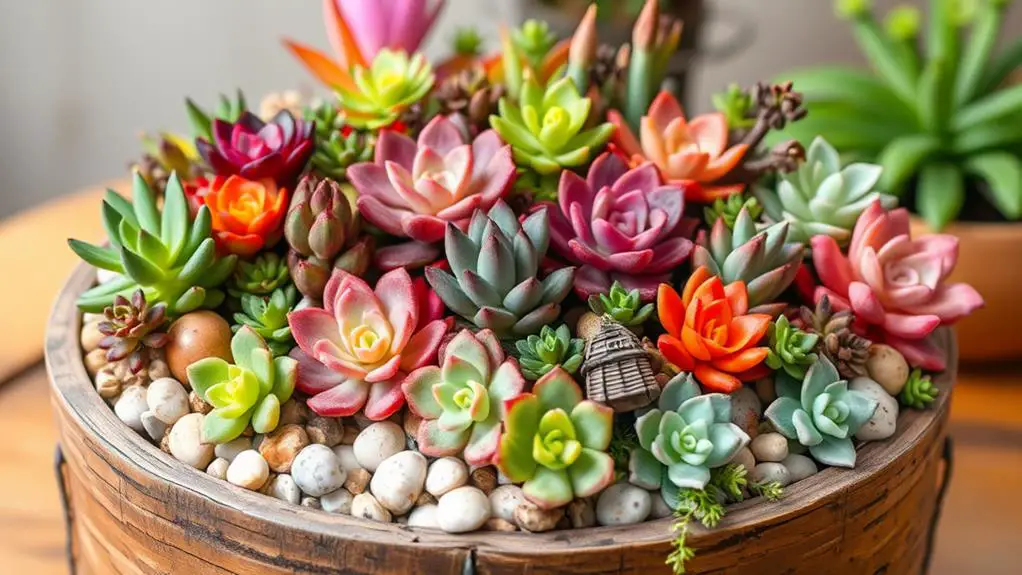
Transforming your succulent bouquet garden into a true work of art involves adding decorative elements that elevate its charm. You can really love the look of your garden by incorporating decorative stones, moss, or crushed rock topdressing. These elements not only enhance visual appeal but also help hide any bare soil, giving your arrangement a polished finish.
Using a variety of textures, like soft moss or rough stones, can create contrast and depth within your design. This makes your bouquet more dynamic and interesting to look at.
When choosing a color palette for your decorative elements, make certain it complements the hues of your succulents. This guarantees a harmonious overall look that ties everything together beautifully.
Experiment with different placements of your decorative elements. You might cluster stones in one area or spread moss around the base of your succulents. This aids in achieving a balanced and visually appealing arrangement.
For an extra touch of personality, consider adding unique items like driftwood or glass accents. These can introduce an organic and artistic touch, making your succulent bouquet garden even more special and personalized.
With these tips, you'll create a garden that's truly stunning.
Watering Techniques
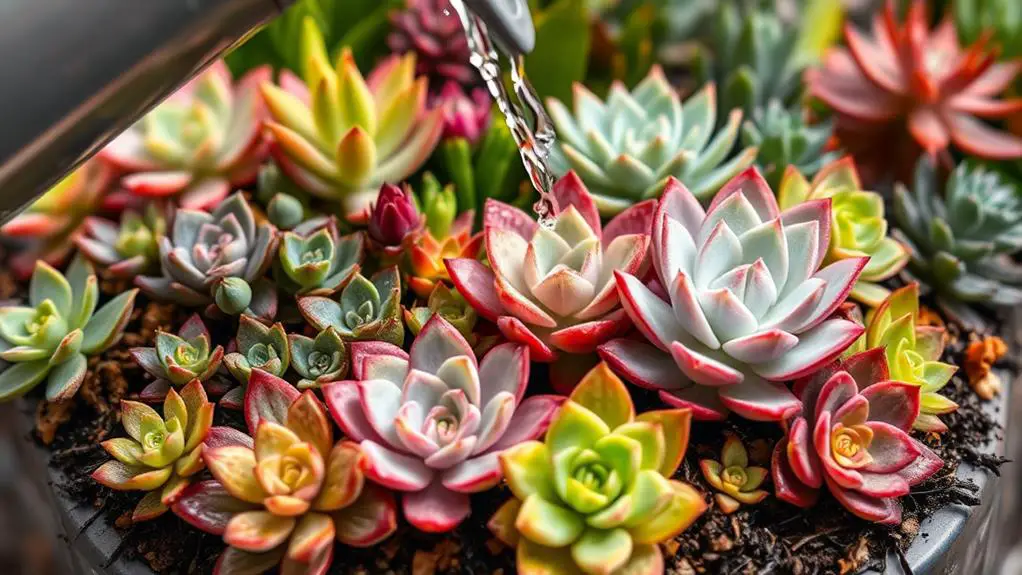
Watering techniques play an essential role in maintaining a healthy succulent bouquet garden. To start, you should water your succulents only when the soil is completely dry. This usually means every 1-2 weeks. Overwatering can lead to root rot, so it's vital to let the soil dry out between waterings.
Using the right tool is also important. A syringe or a watering can with a narrow spout allows you to deliver water directly to the soil, keeping the leaves dry. Wet leaves can lead to fungal infections, which you definitely want to avoid.
Here are some key tips to remember:
- Check soil moisture: Stick your finger about an inch deep into the soil; if it feels dry, it's time to water.
- Adjust for summer: Increase watering frequency during summer months since higher temperatures cause more evaporation.
- Winter dormancy: Reduce watering considerably in winter, as succulents need less moisture when they're not actively growing.
Light and Placement
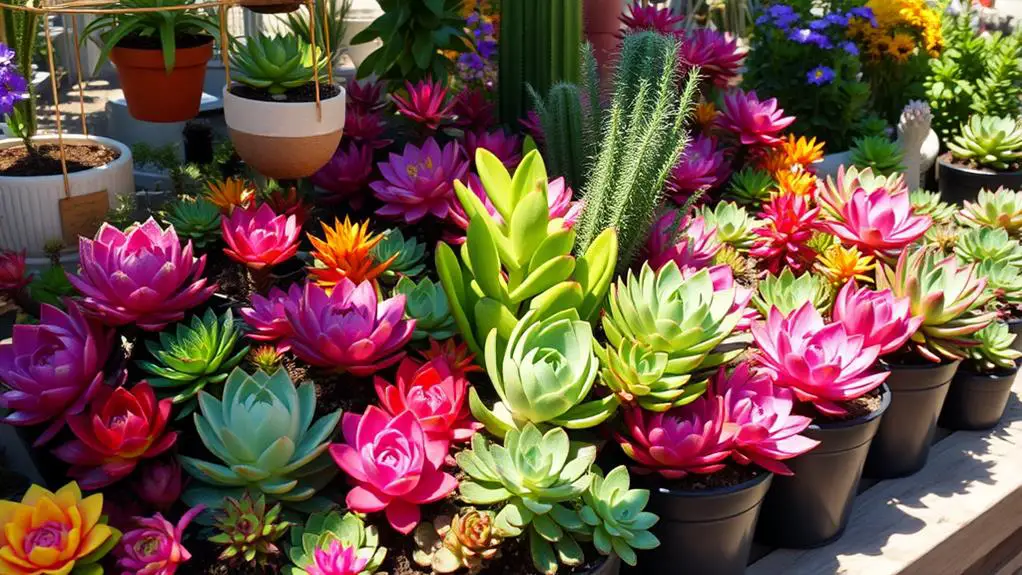
Let's talk about light and placement for your succulents to keep them thriving.
They love bright, indirect light, so a south or west-facing window is perfect, but make sure to avoid direct sunlight for too long to prevent sunburn.
If you're growing them indoors, rotate your arrangement every few weeks for even growth, and if you prefer an outdoor spot, choose a location with partial shade to protect them from the harsh midday sun.
Optimal Light Conditions
Guaranteeing your succulents receive perfect light conditions is essential for their health and vibrancy. Succulents thrive in bright, indirect light, typically needing around 6 hours of sunlight each day. This light helps them grow robustly and maintain their beautiful colors.
However, be cautious of direct, harsh sunlight, as it can lead to sunburn and damage the leaves.
For indoor succulents, place them near south or west-facing windows. These spots usually offer the right balance of natural light without overwhelming exposure. If your succulents are outdoors, select a location that provides partial shade during the hottest parts of the day. This placement will help prevent overheating and dehydration.
To guarantee peak light conditions, make sure to:
- Rotate your succulents regularly so all sides get equal light exposure, promoting even growth.
- Monitor the light intensity and duration to avoid burning or stressing your plants.
- Adjust their position seasonally to match the changing intensity of sunlight.
Indoor vs. Outdoor Placement
When deciding between indoor and outdoor placement for your succulents, understanding their specific light needs is essential.
Indoor succulents thrive in bright, indirect light. A south or east-facing window is perfect since it provides ample light without the harshness of direct midday sun, which can burn the leaves. Keep your indoor succulents in a room where the temperature stays between 60°F and 80°F for ideal health.
Outdoor succulents, on the other hand, need at least six hours of direct sunlight every day. Choose a spot where they receive plenty of morning sun but have some shade in the afternoon, especially during very hot weather. This balance prevents the plants from getting scorched.
Both indoor and outdoor succulents require well-draining soil. For outdoor arrangements, use containers with drainage holes to avoid water accumulation.
Indoors, you'll need to monitor the soil moisture more closely to prevent overwatering. Seasonal changes can also affect light availability, so be mindful of this and adjust their placement as needed.
Rotating for Even Growth
Understanding the ideal placement for your succulents is just one part of the equation; guaranteeing they grow evenly also requires regular rotation. By rotating your succulent arrangements every 1-2 weeks, you make certain all sides receive equal exposure to light. This promotes balanced growth and prevents your plants from becoming leggy or uneven.
Position your succulents in bright, indirect light to really enhance their color and health. Keep an eye on their placement and adjust as needed. Regular rotation has several benefits, including:
- Promoting even growth and preventing one-sided stretching.
- Maintaining consistent moisture levels, avoiding overly dry or damp areas.
- Aligning with the sun's movement to maximize light intake.
During spring and summer, when succulents are actively growing, you might need to rotate them more frequently. This extra attention can make a big difference in their overall health.
Also, watch the direction of natural light in your space. Strategic rotations that follow the sun's path will guarantee every part of your succulent bouquet gets the light it needs.
With these tips, you'll really help your succulents thrive and create a stunning, balanced garden.
Fertilizing Succulents

To keep your succulent bouquet garden thriving, fertilizing during the growing season is essential. Succulents grow best in the spring and summer, so give them a boost with a diluted succulent or cactus fertilizer every 4-6 weeks. This promotes healthy growth and vibrant colors, making your garden look stunning.
When fertilizing succulents, use a liquid fertilizer at about 1/4 strength. This prevents over-fertilization, which can cause root burn. It's important to be gentle, as too much fertilizer can harm your plants. Apply the fertilizer directly to the soil, not the leaves, to avoid leaf burn or damage.
During the winter, when succulents usually enter a dormant phase, they don't need much fertilization. Their growth slows down, so you can skip this step until spring returns.
Keep an eye on the specific needs of different succulent species in your garden. Some may need special types of fertilizer or different schedules based on their growth habits.
Pruning and Grooming
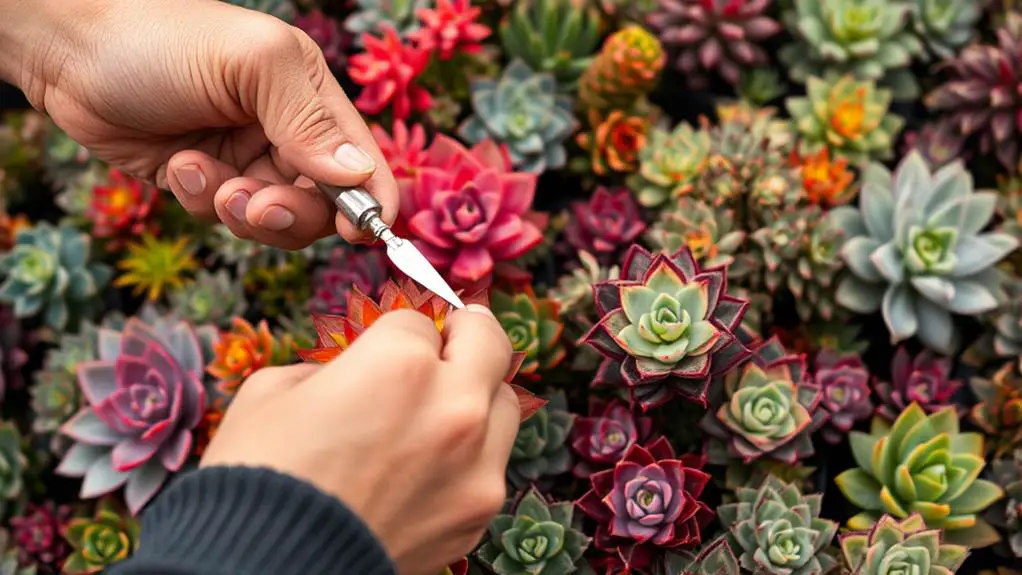
Pruning and grooming your succulent bouquet garden is vital for maintaining its health and beauty. Regularly prune dead leaves and spent flowers to promote overall plant health and encourage new growth.
When you prune, always use clean, sharp scissors or pruning shears to prevent plant damage and reduce the risk of disease transmission.
During grooming sessions, remove any debris or dust from the leaves using a soft brush. This not only keeps your succulents looking their best but also helps prevent pests.
For succulents with leggy growth, trim back excessive stems to encourage fuller, bushier plants. This will improve their appearance and make your garden look more vibrant.
Remember to:
- Prune dead leaves and spent flowers to promote new growth.
- Use a soft brush to remove debris and keep pests away.
- Trim leggy growth to make plants fuller and healthier.
Monitor your succulents closely for signs of pests or disease while grooming. If you spot any issues, take immediate action to address them.
Seasonal Care Tips
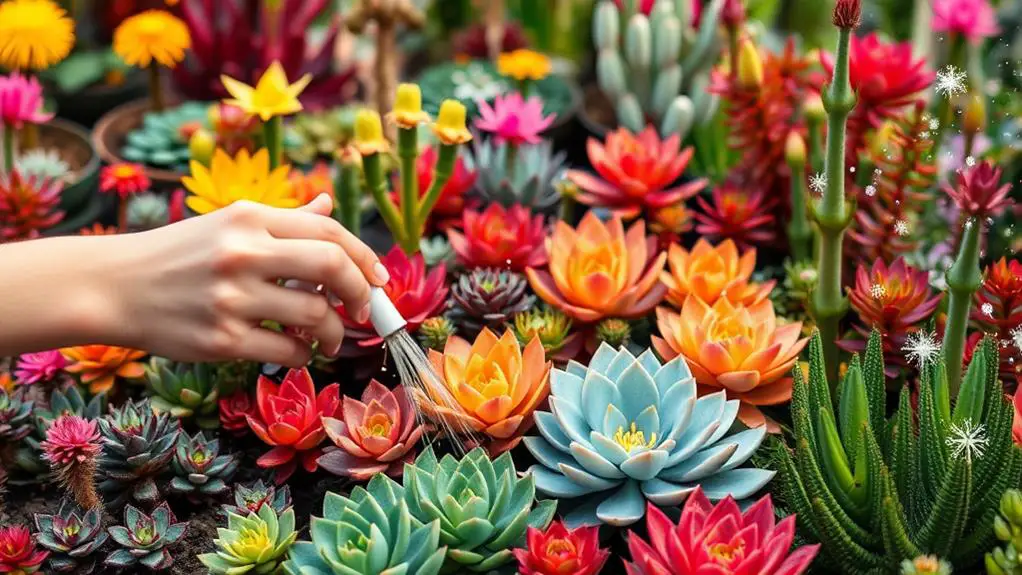
In caring for your succulent garden, it's essential to adjust your watering schedule based on the seasons; water more often in summer and less in winter.
Protect your plants from frost by bringing them indoors or using frost cloths when temperatures drop.
During the growing season, remember to apply a diluted cactus fertilizer monthly to keep your succulents healthy and vibrant.
Adjusting Watering Frequency
Adjusting your watering routine for succulents is key to keeping them healthy throughout the year. In spring and summer, when growth is active, you'll need to water every 1-2 weeks. But remember, this can vary based on your local temperature and humidity.
Always let the soil dry out completely between waterings to prevent root rot, especially in arrangements without drainage.
As the seasons change and temperatures drop, many succulents enter a dormant phase. During fall and winter, adjust your watering frequency to every 3-4 weeks. This reduction helps prevent overwatering when plants need less moisture.
To guarantee your succulents receive just the right amount of water, keep these tips in mind:
- Check soil moisture: Use your finger or a moisture meter to gauge when the soil is dry.
- Monitor plant health: Look for signs of dehydration (shriveling) or overwatering (mushy leaves).
- Adapt to conditions: Be flexible and adjust based on your succulent's needs and your environment.
Protecting From Frost
As winter approaches and temperatures plummet, safeguarding your succulents from frost becomes essential. To prevent frost damage, consider bringing your potted succulents indoors during cold snaps. If moving them isn't an option, cover them with frost cloths or blankets on chilly nights. This will help keep them warm and cozy.
Mulching around the base of your succulents can insulate the soil and roots, reducing the risk of frost damage. Use mulch like straw or wood chips to create a protective barrier. If you're planting succulents in the ground, choose frost-resistant varieties or plant them in a raised bed. Raised beds improve drainage and reduce the chances of the soil freezing.
Keep an eye on local weather forecasts to anticipate frost warnings. Being proactive can save your plants. Watering your succulents before a frost event can help them retain heat. However, don't water if the ground is already frozen, as this may lead to root rot.
Here's a handy table to help you remember these tips:
| Protection Method | Description | Benefit |
|---|---|---|
| Bring Indoors | Move potted succulents inside | Avoids exposure to frost |
| Cover with Frost Cloths | Use cloths or blankets over plants | Keeps plants warm |
| Mulch Base | Add straw or wood chips around base | Insulates soil and roots |
| Choose Frost-Resistant | Select hardy succulent varieties | Better withstands cold |
| Monitor Weather | Check forecasts for frost warnings | Allows proactive protection |
Seasonal Fertilizing Practices
To keep your succulents thriving throughout the year, it's essential to follow proper seasonal fertilizing practices.
During the growing season, which includes spring and summer, you'll want to fertilize your succulents monthly. Use a diluted cactus fertilizer to help promote healthy growth and vibrant colors. A balanced fertilizer with a ratio of 10-10-10 or a specialized succulent fertilizer works best to provide the vital nutrients these plants need.
As the seasons shift to spring and fall, reduce the fertilizing frequency to every 6-8 weeks. During these periods, succulents require less nutrient input, so it's important not to overdo it.
In winter, avoid fertilizing altogether. Succulents enter a dormant phase and fertilizing during this time can lead to nutrient burn and hinder their growth.
Always verify the soil is slightly moist before applying fertilizer to prevent root damage and enhance nutrient absorption.
Here's a quick reminder:
- Fertilize monthly during spring and summer
- Reduce to every 6-8 weeks in spring and fall
- Avoid fertilizing in winter
Frequently Asked Questions
How to Organize a Succulent Garden?
Start by arranging larger succulents in the back or center, medium ones around them, and smaller varieties to fill gaps. Choose complementary colors and forms. Guarantee good drainage and place the garden in bright, indirect light.
How to Make a Succulent Rock Garden?
To make a succulent rock garden, choose a well-draining spot. Mix gravel, sand, and potting soil. Select diverse succulents and add decorative rocks. Water sparingly and let the soil dry out between waterings. Monitor for pests.
How Do You Make a Live Succulent Bouquet?
You start by choosing diverse, healthy succulents. Use a drainage-holed container with a water-retaining base. Secure stems with chicken wire or floral foam. Arrange larger succulents centrally, fill with smaller ones, and water minimally in bright, indirect light.
How Do You Make a Succulent Zen Garden?
You'll need a shallow container with good drainage, a fast-draining cactus mix, and a variety of succulents. Arrange larger plants centrally, add decorative sand or stones, and water sparingly. Remove dead leaves to maintain aesthetics.
Conclusion
You've got all the steps now to create a stunning succulent bouquet garden! With the right materials, thoughtful arrangement, and proper care, your garden will thrive and bring joy. Don't worry if it's not perfect right away—gardening is a journey. Keep experimenting and learning. Remember, each plant is unique and adds its own charm. Enjoy the process and watch your succulent bouquet flourish. Happy gardening!

